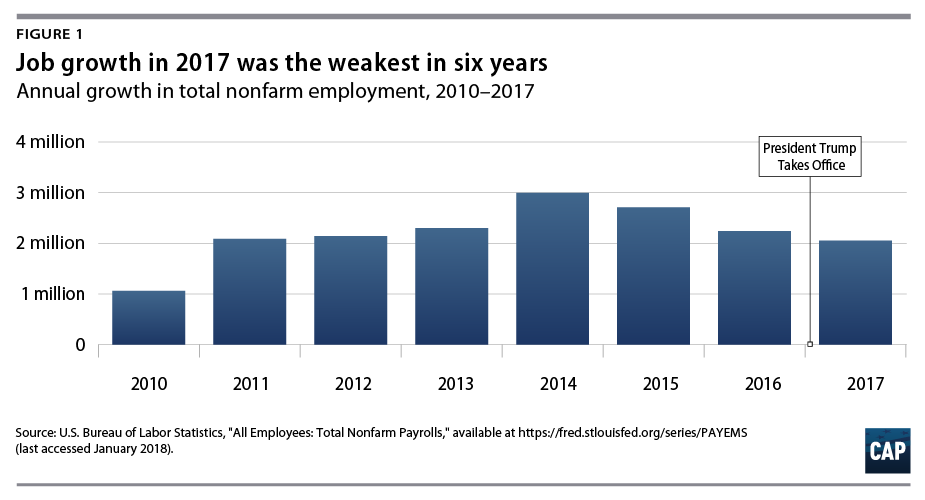State of the Union Preview: Trump Is Rigging the Economy Against Workers and the Middle Class
In his State of the Union address on Tuesday, President Donald Trump is sure to point to stock indexes and other positive economic indicators as evidence of a “Trump boom.” But to the extent that middle-class and working families are doing better economically, it is not because of Trump or his policies; rather, it is in spite of them. Instead of fighting for American workers, as he promised to do during his presidential campaign, Trump has sought in numerous ways to disempower them.
The Trump administration’s fiscal policies are redistributing income and wealth upward through massive new tax breaks to corporations and the wealthy, which come at the expense of middle-class and low-income Americans and investments in key economic priorities such as infrastructure. And by ending the Deferred Action for Childhood Arrivals (DACA) initiative, the administration has thrown the lives of hundreds of thousands of young people—who, with DACA, have been able to get better- and better-paying jobs, buy houses and cars, and make significant economic contributions to the nation as a whole—into chaos.
Moreover, under President Trump’s watch, the economy is not producing the kinds of gains in jobs and wages that will rebuild the middle class. The stock market is up, indicating that corporate shareholders expect strong after-tax profits. But the economy added fewer jobs in 2017 than in any year since 2010, and workers saw barely any increases in real wages.
Trump inherited a years-long economic recovery but has yet to turn it to the advantage of working Americans
Many of the economic trends that President Trump likes to claim as personal accomplishments are simply continuations of trends that began as the economy recovered from the Great Recession and finally gained steam in recent years. Job growth has been strong for several years running, and the unemployment rate has continued to decline steadily. Although the economic expansion continued during Trump’s first year, the results were underwhelming. The economy produced fewer new jobs in 2017 than in any year since 2010.

The growth in real wages for workers in 2017 was even more disappointing. Despite low unemployment, real average hourly earnings grew by only 0.4 percent in 2017—a step backward from increases of 1.8 percent in 2015 and 0.8 percent in 2016.

Wage growth was even more modest for rank-and-file workers. In December 2017, the average hourly wage of production and nonsupervisory workers was $22.30, growing just 4 cents, or 0.17 percent, from the inflation-adjusted December 2016 level. This was the slowest wage growth for these workers in the past four years. Meanwhile, minimum wage workers continued to see their earnings decline in real terms, as President Trump and his colleagues in Congress refuse to raise the paltry federal minimum wage, which has remained stuck at $7.25 per hour since 2009.

Trump administration policies have hurt workers, not helped them
Instead of fighting for American workers, President Trump has taken many actions during his first year in office to hurt workers, hold down paychecks, and undermine families’ economic security. For example, his administration has taken aim at many of the rules that protect workers’ pay. The administration is working to roll back the 2016 rule that expanded overtime protections to 12.5 million workers. The U.S. Labor Department is now pushing a proposed rule to allow business owners to pocket their workers’ tips. And Trump’s appointments to the National Labor Relations Board have overturned several pro-worker rulings, making it harder to collectively bargain for higher wages. The administration has also weakened environmental health and safety protections by rolling back and delaying rules that prevent agriculture and construction workers from being exposed to toxic chemicals and by weakening mine inspection rules.
Trump administration fiscal policies redistribute wealth to those at the top while threatening working families
The administration’s fiscal policies are designed to rig the economy for the wealthy while leaving middle-class and working families behind. President Trump’s most significant legislative enactment in his first year is a massive tax overhaul that provides enormous tax cuts for corporations and wealthy individuals. These tax cuts are paid for through higher deficits; reductions in health care coverage; and over the long run, by permanent tax increases on most households.
Trump claimed that wealthy Americans “will not be gaining at all” under his tax plan. However, millionaires will receive an average tax cut of nearly $70,000 this year—more than 100 times the size of the average tax cut for families in the bottom 80 percent of the income distribution. Wealthy Americans also benefit from a host of new tax cuts, including a large cut in the corporate tax rate; a special new loophole for “passthrough” businesses that benefits wealthy investors, such as Trump himself; a reduction in the top ordinary income tax rate; and a further reduction in the estate tax.
Yet while Trump and other wealthy Americans enjoy these new tax breaks, many working- and middle-class families will lose out. In 2018, 7.8 million families making less than $200,000 per year will see tax increases. That number increases over time, and in 2027, after the bill’s temporary tax cuts expire, nearly 92 million families making less than $200,000 will see tax increases.
The deeply unpopular tax bill—projected to contribute some $1.5 trillion to the deficit over 10 years—will not pay for itself. Rather, in order to reduce that deficit, President Trump and his allies in Congress intend to make deep cuts to programs that help everyday Americans afford basic necessities. Despite Trump’s campaign promises not to make cuts to Medicaid, Medicare, or Social Security, he and House Speaker Paul Ryan (R-WI) have declared their intention to “rein in” these programs and others—code for cutting benefits. If they succeed, an enormous number of Americans will struggle to pay their bills and to put a roof over their heads.
President Trump has already invited states to make unprecedented and possibly unlawful changes to Medicaid that threaten to strip health insurance from at least 6.3 million low-income people—many of whom are caregivers or students—who cannot find work or get enough hours at their job. So far, 10 states have submitted applications to take Trump up on his offer; Kentucky’s proposal has already been approved.
Other programs that help workers and families afford life essentials are imperiled as well. The administration’s fiscal year 2018 federal budget proposed a whopping 29 percent cut to the Supplemental Nutrition Assistance Program—which helps more than 22 million households put food on the table. The budget also proposed ending the Low Income Home Energy Assistance Program, which helps seniors, children, and people with disabilities pay their utility bills; eliminating subsidized student loans, which help more than 6 million undergraduate borrowers afford higher education every year; and scrapping programs that help states provide substance misuse treatment, combat child and elder abuse, support Meals on Wheels programs, and more.
Trump’s deregulation policies hurt workers and have not created jobs
President Trump boasts about slashing regulations; he has said that his goal is to return them to “below the 1960 level.” That was a time before rules that prevent toxins in our water, require seatbelts and airbags in cars, and prevent the use of lead paint in children’s toys. And while his administration expresses concern about regulatory costs to business, there is no evidence for Trump’s claims that his efforts have increased investment or growth; instead, they have only stripped people of important safeguards.
There is, however, plenty of evidence that deregulation hurts many working families. The administration has already gone after protections that ensure eligible workers receive overtime pay, costing the middle class more than $1 billion in lost wages each year. It has also delayed safeguards preventing financial advisers from cheating their clients, which would cost people billions of dollars in retirement savings. The administration is also seeking to roll back restrictions on predatory loans, including payday and car title loans that drain $8 billion in fees each year from struggling families and communities. Trump’s deregulation efforts seem more focused on helping businesses cut corners at everyone else’s expense; in fact, repealing just three of the regulations Trump has targeted would have an annual cost to society of $22.1 billion, all so businesses could avoid the costs of complying with common-sense rules.
With corporations receiving a windfall from their tax cuts and many banks reporting that they are as profitable as ever, regulations do not seem to be standing in the way of growth—especially as lending has rebounded to pre-crisis highs, continuing a trend from before Trump took office. The administration’s deregulation is just another excuse to help the wealthy and powerful at the expense of everyone else.
The administration’s infrastructure plan is inadequate to meet national needs
President Trump’s infrastructure plan does not solve the real infrastructure challenges facing the nation, nor will it create the jobs it promises. Taken together, President Trump’s budget and infrastructure plan call for cutting $338 billion in core federal infrastructure and other discretionary programs. This translates into a cut of $1.69 for every $1 in proposed expenditures. Furthermore, the plan calls for huge increases in state and local taxes, tolls, and other user fees that will hit working and middle-class families hard. Finally, the infrastructure plan pushes states to privatize infrastructure assets and take on expensive private equity capital, which costs 3 to 5 times more than traditional municipal bond financing.
Congress should reject this plan and instead unite in support of a bill that is robust, comprehensive, equitable, and sustainable. This means that the federal government should spend at least $1 trillion over the next 10 years on everything from highways, public transportation, and aviation to affordable housing, water, clean energy, child care facilities, and rural broadband internet, among other things. The bill should be equitable, providing all Americans with safe, affordable, and reliable access to opportunity. Finally, Congress should push for a bill that is sustainable and that protects local communities and natural habitats while ensuring that the United States meets its climate commitments.
Conclusion
On Tuesday night, President Trump will boast that he alone is solely responsible for every positive economic trend taking place. The fact is, however, that he inherited a strengthening economic recovery. His economic policies only hurt American workers, increase the gaps in income and wealth, undermine supports that help families afford necessities, and fail to make needed investments that would enable long-term growth. In 2016, President Trump promised to fight for American workers, but his first year in office has shown that he is decidedly not on their side.

